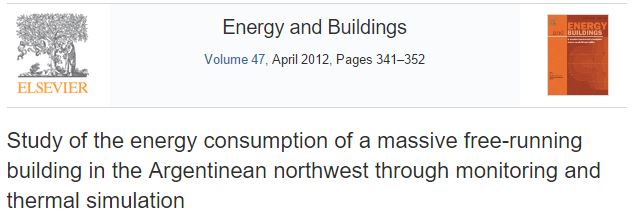
Energy and Buildings 47, pp. 341–352, 2012.
Autores: Flores Larsen S., Filippin C., González S.
Abstract
The investigation presented in this paper has three main objectives. The first one is to study, through a case study, if it is possible to acceptably predict the energy consumption of a massive residential free-running building, when the exact behavior of the occupants is unknown or actual indoor conditions are not monitored, assuming standard use and occupation schedules, for the dry climate of the Argentinean Northwest. The second objective of the paper is to detect the possible causes of differences between actual and predicted energy consumption through an exhaustive thermal monitoring and occupant’s behavior, in order to obtain an improved model of the building giving more accurate predictions of the energy consumption. The third objective is to analyze the effect on the annual energy consumption of changing the massive envelope by a lightweight one. The comparison of real and simulated consumptions under comfort conditions defined by ASHRAE Standard 55 shows that simulations overestimated the energy consumption for heating and cooling. The main causes were detected from the experimental monitoring, indicating a lower use of the air conditioning equipment than the supposed initially. Simulations were improved to consider actual use and occupation conditions. Finally, an annual simulation of the improved model performed by changing the envelope material to a lightweight one showed that energy consumption for heating was increased, while energy consumption for cooling was decreased. In an annual balance, the massive walls are preferable over lightweight ones in arid sunny climates as in the Argentinean Northwest, giving energy savings of around 25%.
Highlights
- The thermal behavior of a massive free-running building in a dry climate was studied.
- The building was monitored in winter and summer and simulated with EnergyPlus soft.
- Energy consumption for heating and cooling were analyzed.
- The effect of using a lightweight envelope was studied through simulation.
- Massive walls are preferable in arid sunny climates with energy savings of 25%.
Keywords
- Energy consumption
- Thermal simulation
- EnergyPlus
- User behavior
- Adaptability